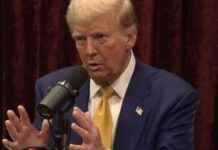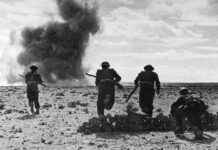Seoul and Washington have extended their largest-ever joint air drills, which involve hundreds of warplanes on both sides, until Saturday after an apparently failed intercontinental ballistic missile (ICBM) launch. by North Korea on Thursday morning.
Pyongyang said extending the drills was “a very dangerous and wrong choice”, and fired three short-range ballistic missiles late Thursday.
Shortly after the announcement, as of 11:28 p.m. local time on Thursday, the Seoul military detected around 80 artillery fire from the North in a maritime “buffer zone” from the Kumkang area of Kangwon province on the coast. east of the country.
This barrage is “a clear violation” of the 2018 inter-Korean agreement which established these buffer zones to reduce tensions between the two sides, the South Korean general staff said.
The United States denounced “the illegal and destabilizing firing of an intercontinental ballistic missile”. Seoul and Washington have vowed to take further steps to demonstrate their “resolve and capabilities” in the face of growing threats from the North.
Pyongyang fired around 30 missiles on Wednesday and Thursday, including one that ended near southern territorial waters for the first time since the end of the Korean War in 1953.
South Korean President Yoon Suk-yeol said it was a “de facto territorial invasion”.
Pyongyang’s provocations, “especially during our period of national mourning, are against humanity and humanism,” Lee Hyo-jung, a deputy spokesperson for Seoul’s Unification Ministry, argued on Friday. a reference to the stampede that killed 156 people in Seoul during Halloween.
– “Reckless development of nuclear power” –
“The government strongly condemns North Korea for its continued threats and provocations, based on our annual and defensive drills, raising tensions around the Korean Peninsula,” she added. She attributed the rise in tensions to Pyongyang’s “reckless nuclear and missile development”.
Called “Vigilant Storm”, the South Korean American exercises constitute “an aggressive and provocative military maneuver targeting the People’s and Democratic Republic of Korea”, denounced Wednesday for its part the North Korean regime, which has threatened Seoul and Washington to “pay the most horrible price in history”.
North Korea has always viewed US-South Korean military maneuvers as dress rehearsals for an invasion of its territory or an overthrow of its regime.
Analysts attribute Pyongyang’s particularly furious reaction this time to the use during ‘Vigilant Storm’ of advanced F-35A and F-35B stealth jets, seen as an ideal tool for carrying out ‘decapitation strikes’ flash against North Korean leaders.
North Korea had already, in September, revised its nuclear doctrine to allow itself to carry out preventive strikes in the event of an existential threat against the Kim Jong Un regime.
If North Korea’s nuclear “command and control system” is “endangered by an attack by hostile forces, a nuclear strike will be launched automatically and immediately,” the new doctrine says.
Seoul and Washington have been warning for months that North Korea is about to carry out a nuclear test, which would be its seventh.
In addition to the “Vigilant Storm” exercise scheduled until Saturday, the South Korean military announced that it will carry out its annual “Taegeuk” exercise next week aimed at “improving wartime performance” and management. of crisis.
It is a computer-simulated exercise conducted to build “the ability to conduct practical missions in anticipation of various threats such as nuclear weapons, missiles and recent provocations by North Korea,” according to the military. South Korean.








